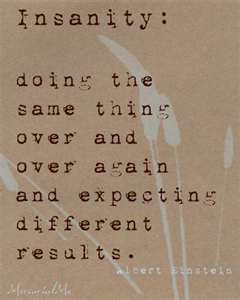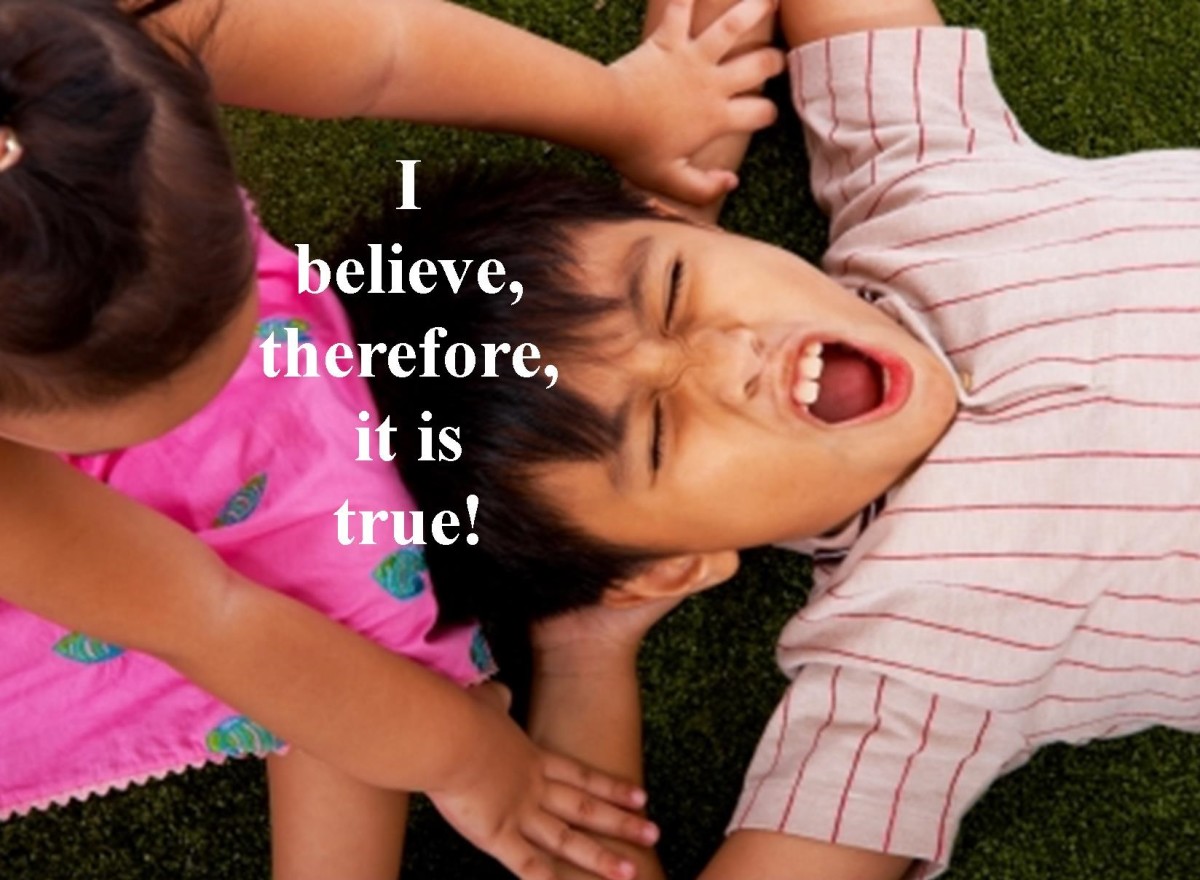Keeping Some Sanity in a World That Seems Completely Insane


There's a Hole in My Sidewalk by Portia Nelson
Chapter One
I walk down the street
There's a deep hole in the sidewalk
I fall in
I'm lost. . . I'm helpless
It isn't my fault
It takes me forever to find a way out
Chapter 2
I walk down the same street
There's a deep hole in the sidewalk
I pretend I don't see it
I fall in again
I can't believe I'm in the same place
But it isn't my fault
It still takes a long time to get out
Chapter 3
I walk down the same street
There's a deep hole in the sidewalk
I see it there
I still fall in. . . it's a habit
My eyes are open
I know where I am
It is my fault
I get out immediately
Chapter 4
I walk down the same street
There's a deep hole in the sidewalk
I walk around it
Chapter 5
I walk down another street
What is Sanity?
Is some sanity enough? Is it necessary to be totally sane? Is it possible to be completely insane? Does the sanity and insanity reside outside of me or within me? If I do something insane, does that make me insane? What does it even mean to “do something insane?”
Actually, the idea of insanity is more of a legal term today than a psychological one: it refers to whether or not a person is mentally competent to stand trial. There is no such psychiatric or mental health condition known as insanity. There are no treatment protocols for insanity.
Yet the words sanity and insanity have meaning to us. We had a sense of what they mean when we read the title. We know they are opposites. We probably value sanity as positive and insanity as negative. Synonyms for insanity are craziness and madness. What is a synonym for sanity?
In the words of Albert Einstein, insanity is defined as, “doing the same thing over and over again, and expecting to get different results.” In Portia Nelson’s popular poem, “There’s a Hole in my Sidewalk,” the speaker is at first victimized by insanity, then falls into insanity again out of familiarity and habit, takes responsibility for that choice, and eventually learns to avoid repeating the actions that lead to insanity. The hole is still in the sidewalk. She is aware of that, and acts accordingly.
Sanity refers to our capacity to see ourselves, others and our world as they really are. It has to do with truth, openness and honesty. It involves a level of acceptance; acceptance of self, others and the world. It refers to the extent that our choices and actions help or hinder our efforts to meet our needs and get some of what we want. It seems to determine the quality of our lives and our relationships with others. It is not a thing that we either have or we don’t have. Sanity is the use of good sense, judgment and reasoning to increase what we value as positive and decrease what we value as negative in our lives.
Jon Kabat-Zinn’s book title, Wherever You Go, There You Are, reminds us to look within when we see conflict in our external world. If we seek one geographic change after another, after another, and insanity seems to follow, there is a good chance that the insanity resides in us and we are projecting it outward onto others and our world. Projection is a defense mechanism we often use that protects us initially, and then deceives us, by allowing us to see negative aspects of ourselves in others but not in ourselves. If we have a very strong reaction to another’s selfishness, there’s a good chance we have a very similar pattern of selfishness in ourselves. The more astute we are at recognizing our use of defense mechanisms, the more accurately we perceive ourselves, others and our world.
Defense Mechanisms
- 1 Definition
- 2 Main Defense Mechanisms
- 2.1 Denial
- 2.2 Displacement
- 2.3 Intellectualization
- 2.4 Projection
- 2.5 Rationalization
- 2.6 Reaction formation
- 2.7 Regression
- 2.8 Repression/Suppression
- 2.9 Sublimation
- 2.10 Compensation
- 2.11 Dissociation
- 2.12 Fantasy
- 2.13 Identification
- 2.14 Undoing
- 2.15 Withdrawal
- 3 Maladaptive Use
- 4 Conclusion
Cognitive Distortions
- 1 All or Nothing Thinking
- 2 Overgeneralization
- 3 Filtering Out the Positive
- 4 Mind Reading
- 5 Fortune Telling
- 6 Emotional Reasoning
- 7 Should Statements
- 8 Labeling
- 9 Personalization
Defense Mechanisms and Cognitive Distortions
There are other defense mechanisms, most notably denial, that keep us from seeing ourselves, others and our reality as they are. Another is minimizing, or making a problem seem less significant than it is. There are also cognitive distortions that allow us to distort reality. The cognitive distortion of magnifying makes a problem seem more significant than it actually is. It makes a mountain out of a molehill. Some other distortions are mind reading, over generalizing, over personalizing, dichotomizing, filtering and splitting.
When we are using defense mechanisms and cognitive distortions, we are not viewing our reality accurately. When we don’t see our reality as it is, we act in a way that is not effective. For example, if we believe we do not have enough of something or fear we will lose what we have, we might engage in hoarding behavior. The hoarding behavior can be seen as being out of control to an objective observer, but not as problematic to the hoarder. If it is not viewed as problematic, the hoarding behavior will continue.
Defense mechanisms often protect us from strong emotional reactions, and cognitive distortions often produce more intense emotions than would be appropriate for a situation. A lack of emotion can keep us from acting appropriately when it is in our best interest to act; it could keep us from jumping out of the way to avoid being hit by oncoming traffic. Intense emotions can prevent us from accepting ourselves and our realities. They can hinder our ability to view our reality accurately, receive accurate information about our reality, and can lead to a distorted view of reality.
If we are overcome with intense guilt or shame when we make a mistake, and don’t know ways to cope with guilt and shame, we might feel a need to put on a façade of perfectionism, or we might avoid any social interaction at all in an attempt to avoid criticism or exposure. If, on the other hand, we accept ourselves as imperfect and recognize that we can learn from mistakes, we are more likely to admit a mistake when we make one, learn from it and avoid the mistake in the future. Our sense of self worth is not threatened, and our response is more effective.
External Stressors
Often, our external environments do contribute to feelings of insanity. We might feel insane when we are actually having a very sane reaction to insane circumstances. This is typical in cases of extreme physical and sexual trauma, violence, natural disasters and combat, as well as in situations involving verbal, emotional and psychological abuse. These experiences have profound affects that can persist a lifetime, and can influence our present day responses to our environment. If our response to past stressors interferes too much with our response to current stress, our response will not be effective and can be problematic.
A combat veteran or a hurricane survivor who immediately dives for cover at the sound of the sudden, loud noise created by a falling book in a college classroom is not acting effectively in the present circumstances. On the other hand, if that loud, sudden noise is the sound of sniper fire in the classroom, the survivor is much better equipped to survive than the rest of us might be if we are not reacting at all.
Some current research is showing a strong correlation between intense emotional reactivity and environments that are rejecting, discounting and invalidating. A person, who grows up in an invalidating and rejecting family or institutional environment, often develops extreme sensitivities to rejection and abandonment, intense emotional reactions, and unstable moods. This emotional intensity and instability naturally produces behaviors that are chaotic, bizarre, irrational and often dangerous.
One aspect of our external environment that has intensified in recent years is the intensely heated, often hostile, and emotionally charged political debates that are getting a great deal of media attention and are being accepted by many as acceptable and appropriate forms of communication. Most of us are affected in subtle ways by these debates whether we are aware of the effects or not. Many people experience these broadcasts as triggers of earlier abuses or as re-traumatizing.
Coping Choices
Using our definition of sanity as “the use of good sense, judgment and reasoning to increase what we value as positive and decrease what we value as negative in our lives,” we can identify some ways to cope with these broadcasts or other stressors that we experience as unwelcome, offensive or intrusive. Some of these ways of coping will be cognitive, involving the way we think, and some will be behavioral, involving the way we respond. They will all help us feel and act in a more sane way.
- Evaluate how positive or negative the stressor is for you and whether you would like more or less of it in your life at this time.
- Examine yourself for use of defense mechanisms or cognitive distortions in regard to the stressor.
- If you evaluate the stressor as negative and would like less of it, take steps toward reducing the stressor, i.e.; turn off the television, watch less television, throw away the television, watch different television shows, stay out of the room where the television is, ask for someone’s help or cooperation, if needed.
- If you evaluate the stressor as negative and would like less of it, but find it difficult to take effective action toward reducing or eliminating the stressor, identify what you believe is hindering you from making the change that you have decided is in your best interest. Go back to step 1 using what you identified in step 4 as the primary stressor.
- If you evaluate the stressor as negative, but would like more of it in your life because you believe it is an important principle worth promoting and debating, and you have examined yourself for defenses and distortions, decide what actions you will take to increase your involvement in the issue; write an editorial or a letter to your representatives, learn more about the subject matter, participate in a tea party or other peaceful demonstration, become more active in politics, etc.
- If you evaluate the stressor as positive, consider increasing your level of involvement in the activity. Consider other priorities as well, and whether or not you have the time or resources to devote to the activity. If desired, take action to make time and resources available.
Some Different Ways to Think About It
- Opposites are not necessarily mutually exclusive. It is possible to like and dislike some things about Bush and Obama, republicans and democrats, and any other opposites. I can like one without hating the other.
- It is not necessary to take sides.
- I have a right to be where I am; as do others have a right to be where they are.
- Opinions are like a?#holes; everyone has them.
- Things aren’t always as they seem; just because the world seems insane doesn’t mean it is.
- Change is constant, nothing is permanent, and this too will pass.
- Remember to see the forest and the trees.
- Good and evil exist in everything; nothing is entirely good or completely evil.
- It’s ok to allow God and Satan to be exceptions to #8, if you really must.
- It is possible to listen to and validate a person, without agreeing with them.
- Some people do argue to win, but it is not necessary.
- Some people argue to persuade or change others. The choice to change still belongs to me.
- Some people argue because they enjoy it. Do I?
- Some people argue to prove that you are stupid or wrong; it doesn’t mean you are.
- Some people argue well about things that are unimportant.
- Some people argue terribly about things that are important.
- I have no control over other people.
- If I don’t like that much arguing in my life, I can take steps to change how much arguing I allow in my life.
- When a person disagrees with me, that doesn’t make them stupid or incompetent.
- When I disagree with a person, that doesn’t make me stupid or incompetent.
- It is possible for two people with different opinions and a desire for truth to have a meaningful dialogue.
- It is possible to disagree without arguing.
- It is possible to show respect while disagreeing.
- People change, needs change and the world changes.
- Life is sometimes uncomfortable and isn’t always fair.
- Only God knows everything.
- I can’t predict the future.
- I am not God.
- Sometimes it is better to increase our tolerance for discomfort and uncertainty than to get rid of them.
- Sometimes is better than always and never.
- I’ve run out of ideas. If you have any, please leave them in the comments. Thanks.








